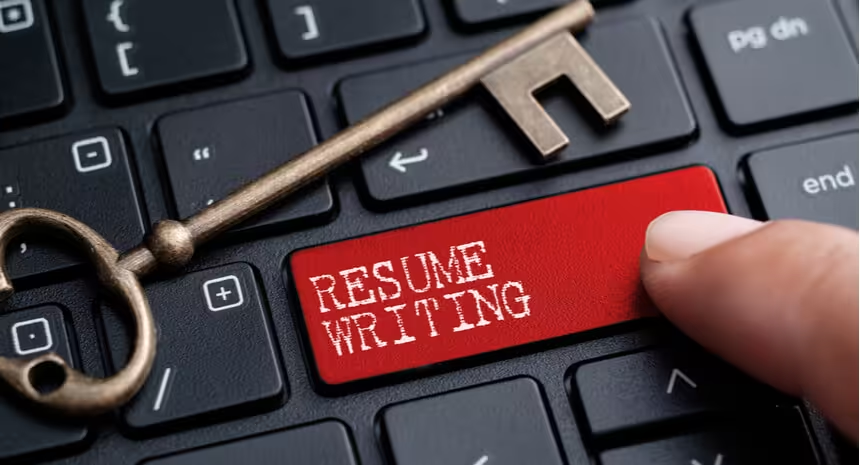Table of contents
You’re a meticulous underwriter with a keen eye for risk assessment. From managing a diverse portfolio of insurance policies to collaborating with a range of financial experts, your thoughtful and confident decision-making can be the difference between a profitable venture and a financial setback. Developing your attention to detail and financial acumen is the hard part. Now that you’ve got that covered, allow us to help with the easy part: writing a resume that demonstrates what you have to offer.
With the help of our underwriter resume samples and tips from our career experts, writing a great underwriter resume is easier than you might think. Let’s dive in!
This guide will cover:
- Inspiring underwriter resume examples.
- Steps to write a persuasive underwriter resume in 2025.
- Optional sections for your resume.
- The importance of writing a cover letter.
- Key takeaways for your resume-writing journey.
Interested in generating a professional resume in just a few minutes? Try our AI Resume Builder. Choose a format that aligns with your professional style and receive expert guidance for each section, ensuring your content effectively highlights your analytical skills and financial expertise.
Underwriter resume examples
Why this entry-level underwriter resume sample works?
-
Simple design
For some creative fields, a resume with lots of visual interest and design elements is a good way to stand out, but for an underwriter this would likely only serve as a distraction. This insurance underwriter resume sample is strong because it is simple, professional and easy to follow.
-
Incorporates soft skills
Financial expertise is essential for an underwriter, but soft skills like communication and adaptability are just as important. This resume is well-rounded because it addresses both.
-
Goal-oriented
This candidate’s experience is somewhat limited, so he opens his resume with a resume profile that focuses on his career aspirations. This demonstrates a growth mindset and avoids drawing attention to the experience that this candidate lacks.
Why this experienced underwriter resume sample works?
-
Focuses on experience
This resume places the candidate’s experience front and center. This is ideal because this candidate has over 15 years of experience to showcase.
-
Uses numerical data
Numbers give the achievements on this resume a sense of legitimacy and impact. This example insurance underwriter resume is stronger thanks to the sense of real-world achievement that the numerical data provides.
-
Uses active verbs
Action-packed verbs like “evaluated” and “assessed” give this experienced underwriter resume sample an extra oomph and energy.
Related resume examples
Looking for more inspiration? Check out our other insurance resume examples:
Browse other popular samples
Choose a resume format for your underwriter resume
To put your best foot forward, you must choose a resume format that emphasizes your strong points. Your selected format should effectively tell your story without focusing on areas where you may have gaps in qualifications. Consider which of these three formats aligns with your career profile:
- The chronological resume format is suitable for experienced underwriters. It presents your underwriting progression in reverse-chronological order, allowing potential employers to trace your growth in the field — including significant projects you’ve overseen and specific roles you’ve held over the years.
- The combination resume format skillfully combines your career history with a comprehensive skills section. This format works well for midcareer underwriters and candidates looking to change careers.
- The functional resume format emphasizes your underwriting skills, making it an excellent choice for underwriters entering the field or transitioning from roles such as internships or academic programs.
Now that you’ve chosen the perfect format, it’s time to select your resume template.
Choose the right resume template for your underwriter resume
Your resume template should organize your information well and be easy to read while maintaining the appropriate level of professionalism and style.
For underwriters who want a professional resume quickly, a simple resume template may be the ideal choice. Its minimalist design eliminates distractions.
For a resume that leaves a lasting impression, consider a creative or modern resume. These styles add a touch of personality and allow you to showcase your personal brand.
Given the competitive landscape in the underwriting field, many hiring managers will receive numerous applications. This is why your choice of template is crucial. Your resume template should leave a strong impression while organizing your information clearly and elegantly.
Our resume templates are available in various file types. Word resume templates and Google Doc templates are perfect free options for downloading and customizing to suit your unique needs.
Now that you’ve curated the perfect resume style, it’s time to dive into the writing process.
How to write an underwriter resume in 5 simple steps
Your resume is your story. Now that the style of the document is settled, it’s time to write that story. Each section gives you the opportunity to show what you can do and highlight your ability to thrive in future underwriter roles. We’ll walk you through it!
Step 1
Review the underwriter job listing for keywords
These days, a resume has two audiences: the hiring department and the applicant tracking system (ATS). Not every role uses ATS, but many do, so it’s important to write a resume that stands up to ATS scrutiny and makes it into human hands. To do this, your resume should be tailor-made to the job listing.
To create a resume that passes through ATS systems, keep an eye out for keywords or phrases that the listing uses to describe their ideal candidate’s qualifications. These are the phrases that ATS will likely screen for.
Step 2
Summarize your career achievements
Every resume begins with an introduction to your career in the form of a resume profile. There are two primary types of resume profiles: professional summaries and career objectives, both of which can be a strong choice for your resume, depending on your underwriting career history.
A professional summary provides a comprehensive snapshot of your underwriting career, ideally suited for those with extensive and consistent experience in the field of underwriting. It holds particular significance for underwriters who have made a substantial impact, such as overseeing complex risk assessments or reshaping underwriting team dynamics.
On the other hand, a resume objective outlines your career goals. It is an excellent choice for underwriters who might be new to the profession, such as recent graduates or individuals transitioning from other financial roles. This format underscores your enthusiasm, transferable skills and the unique perspectives you bring to the realm of underwriting.
Let’s explore how each of these would appear on an underwriter’s resume.
Underwriter professional summary example:
Experienced underwriter with over a decade of expertise in conducting thorough risk assessments and leading high-performing underwriting teams. Recognized for translating complex financial data into actionable insights and consistently surpassing client expectations. Proficient at aligning underwriting strategies with business objectives to drive financial success.
Underwriter resume objective example:
Aspiring underwriter with a strong foundation in financial analysis and a dedication to precision. Eager to leverage analytical skills, teamwork abilities and strategic mindset to enhance risk assessment and support financial decision-making. Committed to pushing the boundaries of underwriting excellence and delivering valuable outcomes in the dynamic world of finance.
Step 3
Highlight your essential underwriter skills
Your skills are the thing that allows you to get the job done. Your resume’s skills section should highlight both your technical abilities or “hard skills” and your more subtle interpersonal talents or “soft skills.” Let’s examine both.
First, there are hard skills. As an underwriter, this includes expertise in risk assessment software, financial analysis, policy evaluation and a deep understanding of insurance principles. Your hard skills are the techniques and expertise that you’ve gained through training and experience.
The second group is known as soft skills. Your soft skills relate to your interpersonal qualities and leadership attributes. Effective communication, collaboration with underwriting teams, analytical thinking, adaptability to changing market conditions and the ability to guide your team are vital in the world of underwriting.
Your role as an underwriter is pivotal in assessing risk and safeguarding financial stability. Your skills should reflect your ability to conduct thorough risk assessments and deliver valuable results.
Let’s explore the skills commonly featured on underwriters’ resumes.
Key skills for an underwriter’s resume
- Proficiency in risk assessment software
- Financial analysis
- Policy evaluation
- Insurance principles
- Claims processing
- Effective communication
- Team collaboration
- Analytical thinking
- Adaptability to changing market conditions
- Leadership in underwriting projects
Here’s an illustration of a compelling skills section for an underwriter’s resume:
- Proficient in conducting comprehensive risk assessments and leading underwriting teams.
- Experienced in using advanced risk assessment software for accurate evaluations.
- Skilled in financial analysis and policy evaluation for precise underwriting decisions.
- Effective communication skills for interacting with clients and colleagues.
- Demonstrated ability to adapt swiftly to evolving market conditions.
- Efficient in guiding and supervising underwriting teams to ensure accurate assessments.
Stay updated on the latest trends and innovations in the insurance and risk assessment industry, including new software and emerging techniques. Demonstrating your awareness of cutting-edge practices and tools can highlight your commitment to delivering precise underwriting results.
Step 4
Describe your underwriter work history
Whether you have decades of experience or just one year, your work history is where you demonstrate that you know how to apply your skills and knowledge.
When writing your work experience section, you’re doing a lot more than providing a laundry list of previous roles. Your experience also shows your skills, competencies and understanding of the needs and responsibilities of the role.
This is where you show potential employers that you know how to achieve results.
To showcase your contributions, utilize action words in your resume. Words like “analyzed,” “led,” and “innovated” emphasize the energy and expertise that you bring to your role.
Example underwriter work history entry:
Underwriter, Financial Assurance Inc.
New York, NY
March 2019 – December 2022
- Managed a high-performing underwriting team, overseeing complex risk assessments and driving projects to success.
- Served as a vital link between clients and the underwriting team, ensuring clear communication and client satisfaction.
- Formulated and executed precise risk assessment strategies that exceeded client expectations, resulting in a 25% reduction in risk exposure.
- Implemented advanced risk assessment software and techniques to streamline underwriting processes, reducing evaluation times by 20%.
- Mentored and motivated the underwriting team, fostering their skills and elevating the company’s underwriting standards to industry-leading levels.
Illustrate your accomplishments with quantifiable metrics. Whether it’s reduced risk exposure, accelerated evaluation times or elevated underwriting standards, numbers show that you’ve had a concrete effect on previous roles.
Step 5
Showcase your education
Your education is a major part of your career journey. When writing your education section, be sure to list your degrees in reverse-chronological order and don’t forget to include any additional training you’ve received in your field.
How to present your education and credentials:
EDUCATION
B.A. in Finance and Risk Management
University of Chicago, Chicago, IL
CERTIFICATIONS
- Certified in Risk Assessment Strategies, Institute of Risk Management
- Advanced Financial Modeling Certification, CFA Institute
- Professional Underwriting Techniques Certification, Insurance Institute of America
Additional sections for your resume
Languages
Fluency in multiple languages is a highly sought-after professional skill that demonstrates mental acuity and communication excellence. If you speak any additional languages, include them in an optional section.
How to list languages on your resume:
- Fluent in English and Italian
- Proficient in French
Hobbies and interests
Hobbies can give your resume a sense of personality. It is good to demonstrate your well-roundedness as an individual. Just be sure not to include hobbies that are irrelevant or inappropriate for the job you’re seeking.
How to feature hobbies and interests on your resume:
- Developed a financial literacy app, providing users with insights into managing personal finances effectively.
- Participated in charity runs to raise funds for financial education initiatives, combining my passion for running with support for financial literacy.
Community engagement and collaboration
Highlighting your involvement in community projects, particularly those related to financial education or community outreach in the finance sector, showcases your dedication and genuine interest in fostering financial literacy beyond your professional role.
How to showcase community engagement on your underwriter resume:
- Collaborated with local schools to initiate financial literacy programs, promoting financial education among students and supporting their financial development.
- Participated in community financial wellness workshops, providing guidance on budgeting and financial planning to empower local residents.
resumes made with Resume Now!
Add a cover letter
A strong cover letter is more than just the cherry on top of a great resume. It is a necessary step to ensure that your resume achieves the maximum impact on the hiring departments that receive it. Your cover letter is your opportunity to add context to your resume — explain any career changes or employment gaps and demonstrate why you think you’re the right fit for the role, why you want the role, and what excites you about it.
Your cover letter can be used to draw attention to achievements that you did not have the space to explain in detail on your resume. Also, if your resume involves an unconventional career path with gaps or career changes, a cover letter gives you the opportunity to explain yourself.
For expert guidance on creating a persuasive cover letter, explore our comprehensive guide on how to write a cover letter and gain inspiration from our extensive collection of cover letter examples.
To maintain a cohesive visual identity between your cover letter and resume, consider utilizing a professionally designed cover letter template from our Cover Letter Generator.
Key takeaways for your underwriter resume
-
Personalize your resume for each opportunity
Tailor your resume to align with the specific requirements of each underwriter role, emphasizing your skills in risk assessment, financial analysis and policy evaluation.
-
Highlight your underwriting experience
Showcase your hands-on involvement in underwriting projects, from risk assessment to decision-making, demonstrating your ability to excel in a dynamic and ever-evolving financial environment. Check out some insurance underwriter resume examples to help you get started on a work experience section that shines.
-
Emphasize your dedication to continuous learning
Highlight any advanced courses, certifications or workshops you’ve undertaken in the realm of underwriting, underscoring your commitment to staying updated on the latest industry trends and cutting-edge practices.
-
Express your passion for meticulous risk assessment
While your resume provides a snapshot of your skills, a well-crafted cover letter gives you extra opportunities to communicate your enthusiasm and draw attention to key accomplishments and competencies.
-
Highlight measurable achievements
If you’ve contributed to reduced risk exposure, accelerated evaluation times or elevated underwriting standards, emphasize these accomplishments with concrete metrics and results.
-
Showcase collaboration and team leadership
No man is an island! Your resume should demonstrate how well you thrive in a collaborative team environment. Highlight instances where you’ve effectively collaborated with cross-functional teams, showcasing your ability to lead and support in achieving precise underwriting outcomes within a group setting.
Frequently asked questions from job seekers
Last Updated: January 01, 2025
- How do I list references on a resume?
- How important is font size on a resume?
- How do I prepare for a phone interview?
- What are computer skills and why are they important?
- How do I list technical skills on my resume?
- What questions should I expect to answer in an interview?
- How do I prepare for an interview?
- What are core competencies and how do I list them on a resume?
Was this information about Underwriter Resume: Examples, Templates And Tips For 2025 helpful? Let us know!
Hailey Brophy is an experienced writer with a diverse career in digital publication. She is passionate about using her unique skills and experiences to help job seekers find the information that they need to succeed.
More resources

How to Write a Resume: Guide & Examples for 2025
If you re wondering how to write a resume that grabs attenti...

Should You Put Your Address on Your Resume? (Guide + 5 Example Resume Headers)
Should you put your address on your resume? We ll answer you...

Director of Operations Resume: Examples, Templates & Tips for 2025
Ready to explore an exciting new role as a director of operati...

Professional Tutor Cover Letter Sample & Writing Guide
A standout cover letter for a tutoring job should showcase you...

Free School Guidance Counselor Cover Letter Templates
Showcase your passion for guiding your students in a compellin...



